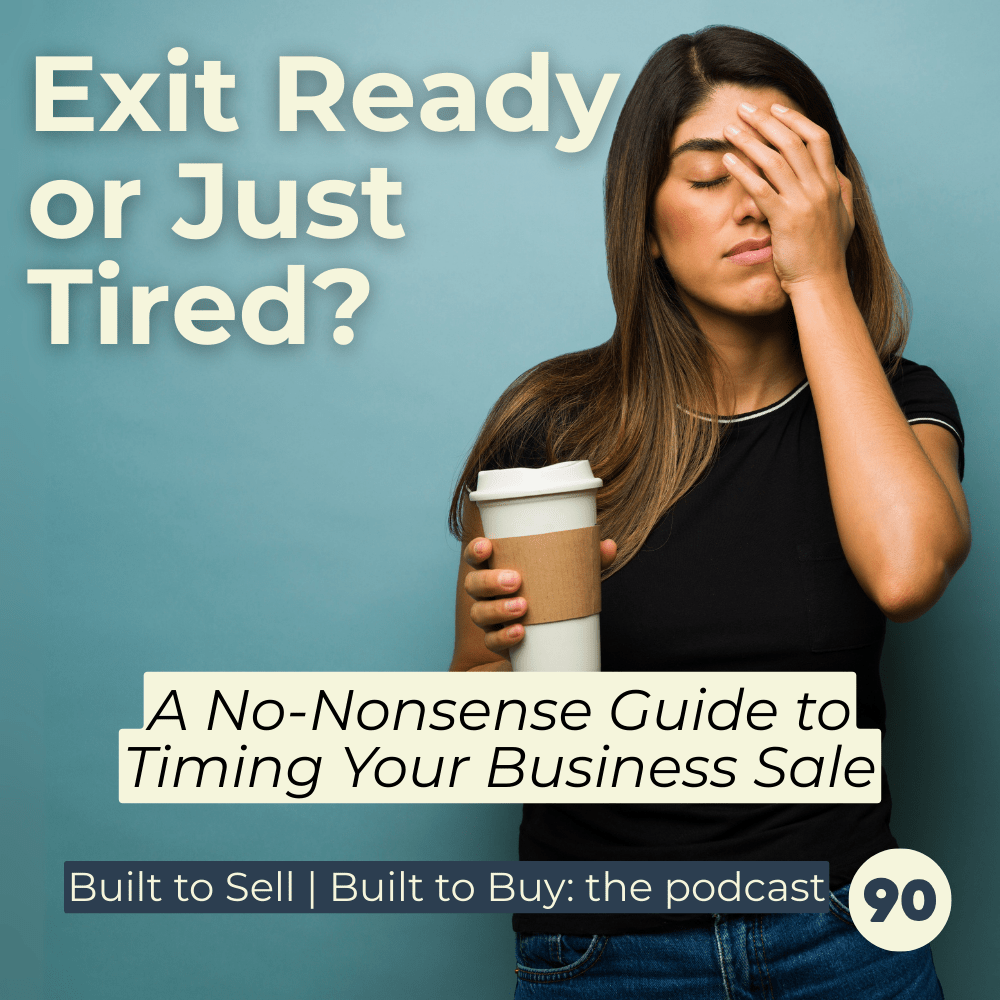
Exit Ready or Just Tired? A No-Nonsense Guide to Timing Your Business Sale
Share
Exit Ready or Just Tired? How to Time Your Business Sale (The Complete Guide)
Too many owners confuse burnout with readiness. This long-form guide shows you how to tell the difference, build exit readiness, and sell for a premium—on your timeline and terms.
Introduction: A Decision Worth Millions
Most owners only sell once. That one decision can be the difference between closing a chapter you’re proud of—or wishing you’d waited, prepared, or pushed just a little longer. The big trap? Confusing being tired with being ready. Burnout is emotional. Readiness is structural. Buyers pay for structure, systems, and future potential; they discount fatigue.
Use this guide alongside the episode below. Watch it now or keep it open while you work through the scorecard and checklists.
Direct link: https://youtu.be/-oWLorwdDNI
On this page
The High Stakes of Exit Timing
Timing matters more than most owners think. The “market” isn’t just the economy; it’s also your category dynamics, competitor behaviour, investor appetite, technology shifts and even your own personal energy. Exiting in a window where those variables line up is how you create competition among buyers—and competition is what moves multiples.
Two common timing errors
- Selling too soon (the fatigue exit): You’ve had a tough year, you’re over the noise, and you accept the first decent offer. Twelve months later, the buyer implements the systems you’d planned to, and the business doubles. You didn’t sell a company; you sold your own upside.
- Waiting too long (the perfect moment myth): You want “one more year of growth” to push the price. The market softens, a new entrant undercuts pricing, and you return to a buyer who now wants a discount to “fix” things you could have addressed earlier. Momentum is a fragile thing.
Great exits rarely happen by accident. They’re built deliberately—long before you hire a broker or take a buyer call.
Burnout vs Readiness: Know Which One You’re In
Burnout is about you. It looks like fatigue, frustration, short-term thinking, and the sense that everything depends on you. Burnout responds to rest, delegation, and fresh leadership rhythms.
Readiness is about the business. It’s measurable. It shows up as clean numbers, documented processes, leadership depth, defensible positioning, and a credible growth story the next owner can execute.
Three lenses to separate emotion from structure
- Personal energy: If you had a capable GM and a free month, would you want to keep going? If “yes”, you’re probably tired, not done. Fix the role before you fix the price.
- Business health: Would the business perform the same if you disappeared for 90 days? If the answer is “not yet”, you’ve got key-person risk. Buyers will discount it.
- Market dynamics: What external forces are tailwinds or headwinds in the next 12–24 months? If you’re about to benefit from industry momentum, be thoughtful about exiting too early.
Two businesses with identical revenue can achieve wildly different outcomes because one is ready and the other is owner-reliant. Readiness is risk reduction—and buyers pay for reduced risk.
The Exit Readiness Scorecard (8 Drivers)
Rate each driver from 1–10. Be blunt. Any score under 7 is a signal to build before you sell.
- Financial quality & trends: Three years of accurate P&L, balance sheet and cash flow; clear add-backs; stable or rising EBITDA. Questions: Are your management accounts timely and consistent? Could an outsider reconcile them in a week?
- Owner independence: The business operates cleanly without you. Questions: Could you take a three-month holiday without disruption? Who signs deals, approves spend, and makes product decisions?
- Systems & documentation: SOPs for sales, ops, finance, support; system map; access controls. Questions: Are the top 10 revenue-critical processes documented and measurable?
- Leadership & succession: A bench of capable leaders with clear accountabilities. Questions: Is there a named successor for each critical function? Are meetings, rhythms and KPIs embedded?
- Customer mix & concentration: No single client or channel dominates revenue. Questions: What’s your top-customer percentage? How diversified is your pipeline?
- Recurring revenue & unit economics: Predictable revenue with healthy gross margin, LTV/CAC and payback. Questions: Are your cohorts strong? Do your margins improve with scale?
- Growth story & scalability: A credible, evidenced plan the buyer can execute—new segments, products, or geographies with operating leverage. Questions: Can you point to proof that the strategy works (pilots, case studies, pipeline)?
- Risk, legal & IP: Contracts, leases, trademarks, licences, privacy/compliance and an IP register in order. Questions: Could a buyer’s lawyer review your pack without raising red flags in the first week?
What Buyers Really Pay For
Buyers aren’t purchasing your past; they’re underwriting your future. The more predictable and transferable that future looks, the higher your multiple. Here’s what sophisticated buyers want to see early:
Due diligence signals that create confidence
- Clean, reconciled financials with consistent accounting policies and explainable adjustments.
- Evidence of repeatability (SOPs, dashboards, QA, training) over personality-driven outcomes.
- Customer diversification and churn under control; no precarious reliance on one account or founder relationships.
- Sound unit economics (gross margin, contribution margin, LTV/CAC, cash conversion cycle).
- De-risked handover (transition plan, stay bonuses, vendor training schedule).
- Compliance and IP tidy (data, privacy, licencing, trademarks, assignments).
Buyer red flags that reduce price or kill deals
- Key-person dependency (founder is the rainmaker or chief problem-solver).
- Messy or late financials; surprises between management accounts and statutory reports.
- High customer concentration or short, cancellable contracts.
- Unclear pricing/margin discipline; discounting to chase revenue.
- Litigation, compliance holes, or IP ownership ambiguity.
Premium multiples are justified when a buyer believes they can step in, follow the playbook, and scale without drama.
Three Short Case Studies (Names Changed)
1) Selling too soon: “Relief now” cost $1.8m later
A services firm owner burnt out after a tough hiring cycle and accepted a quick sale. The buyer retained the team, implemented the already-drafted SOPs, introduced a second-tier leader, and expanded margin by 6% within a year. That value could have been the seller’s with a six-month reset and a calm sale process.
2) Waiting too long: The “one more year” that never came
A product company delayed exit to show one more growth year. A competitor launched a cheaper alternative, compressing margins. Buyers returned—but with new risk adjustments and a lower multiple. Instead of selling on strength, the owner negotiated under pressure.
3) Timing it right: Built to be bought
A founder stepped back from day-to-day, installed a capable GM, documented the top 20 processes, and front-loaded due diligence (customer contracts, IP, compliance). With the growth story evidenced through pilots and pipeline, they ran a quiet process and created competition among three buyers. Clean, fast diligence; strong terms; smooth handover. The difference wasn’t luck—it was readiness.
The Emotional Side of Exiting (That No One Warns You About)
Exits aren’t only financial events; they’re identity events. If you’ve built your business for years, stepping away can feel like losing a piece of yourself. That’s why owners sometimes sabotage their own process—going cold on buyers, moving goalposts, or clinging to decisions only they can make.
Plan your “second act” early
- Purpose: What problem excites you now—advisory, another venture, community projects, time with family?
- Structure: Will you stay for an earn-out or consult? For how long? On what terms?
- Lifestyle: Design the first 90 days post-settlement—health, relationships, travel, a new routine.
Clarity about life after exit reduces last-minute wobbles and helps you negotiate with conviction. You’re not running from something; you’re running towards something.
A 12-Month Roadmap to Build Exit Readiness
This plan is realistic for most small to mid-sized businesses. If you need a faster timetable, compress the cadence and increase resourcing—but keep the sequence.
Quarter 1: Clean the core
- Monthly management accounts standardised; close within 10 working days.
- Revenue recognition consistent; add-backs clearly documented.
- Top 10 revenue-protecting processes documented (Sales → Invoicing → Cash).
- Owner calendar audit: delegate approvals, create a decision rights matrix.
Quarter 2: Build leadership & systemise
- Install meeting rhythms (weekly leadership, monthly performance, quarterly strategy).
- Scorecards for each function; single points of accountability.
- Train a second signatory for supplier negotiations and pricing.
- Customer concentration plan—upsell/cross-sell, new segments, contract extensions.
Quarter 3: Prove the growth story
- Pilot one new channel or product with unit economics tracked.
- Case studies and reviews assembled; brand assets tidied.
- Three-year plan: markets, products, operating leverage, capex assumptions.
- Start assembling the data room (see checklist below).
Quarter 4: Assemble the deal room & test
- Index documents; create a one-page investment memo and a 10–12 page information pack.
- Friendly diligence: ask an advisor to review and poke holes—fix gaps now, not under a buyer’s clock.
- Decide non-negotiables (price range, structure, people outcomes, earn-out terms).
- Map your buyer universe; decide whether to run a narrow or competitive process.
Deal Room Checklist (What to Prepare in Advance)
- Financials: 3 years P&L, balance sheet, cash flow; management accounts; budgets; KPI dashboards.
- Tax & legal: tax returns, BAS, licences, permits, leases, loans, insurances, litigation status.
- Customers & suppliers: contracts, terms, renewal dates, concentration analysis, churn metrics.
- People: org chart, role descriptions, employment agreements, incentive plans, key-person risk map.
- IP & brand: trademarks, assignments, IP register, style guide, brand assets, case studies, reviews.
- Systems: architecture map, access list, data flows, privacy/compliance, SOPs for critical processes.
- Growth plan: three-year model, assumptions, pipeline evidence, pilot results, sensitivity analysis.
- Transition plan: training schedule, stay bonuses, governance during handover, communications plan.
Need Momentum? Run a 90-Day Sprint
If you’re aiming to approach buyers within six months, use this condensed programme:
- Weeks 1–2: Rapid audit; fix “disqualifiers” (late accounts, missing contracts, unclear IP).
- Weeks 3–6: Document top processes; install leadership rhythms; address customer concentration.
- Weeks 7–10: Build the buyer story (unit economics, pilots, case studies); draft the info pack.
- Weeks 11–12: Assemble the data room; run friendly diligence; lock your non-negotiables.
Buy-Side Insights: How Buyers Read Your Business
“We pay for predictability.”
Predictable cash flows with clean, reconcilable reporting are worth more. This is why standardised monthly accounts and stable EBITDA trends matter so much.
“We discount key-person risk.”
If you’re the product, the price falls. Build a team, document your IP, and remove yourself as the bottleneck.
“We want a playbook we can run.”
Give the next owner a clear plan they can execute without heroics—channels to expand, products to roll out, costs to optimise.
The Four-Question Self-Check
- Could you disappear for 90 days and have targets still be hit?
- Would a buyer say “yes” after your first information pack?
- Is EBITDA stable or rising on clean, timely accounts?
- Is there a written transition plan with named owners and dates?
Any “no” reveals where to focus before you speak to buyers. Fixing these ahead of time is often the difference between a tidy, premium exit and a messy, discounted one.
Bringing It Together: Exit Ready Beats Exit Weary
The aim isn’t to sell at any price; it’s to sell at the right price, on the right terms, at the right time. That means separating emotion from structure, building independence from the owner, proving your growth story, and preparing the deal room before anyone asks. Do that, and you’ll move from hoping for a good outcome to engineering one.
Next steps
- Take the free Business Sale Readiness Report to get your score and a focused improvement plan.
- Listen to the full episode for additional context: Spotify · Apple Podcasts · YouTube
Tags
Exit planning Business sale Valuation Owner independence Due diligence© Sam Penny — Built to Sell | Built to Buy. Written in Australian English.
